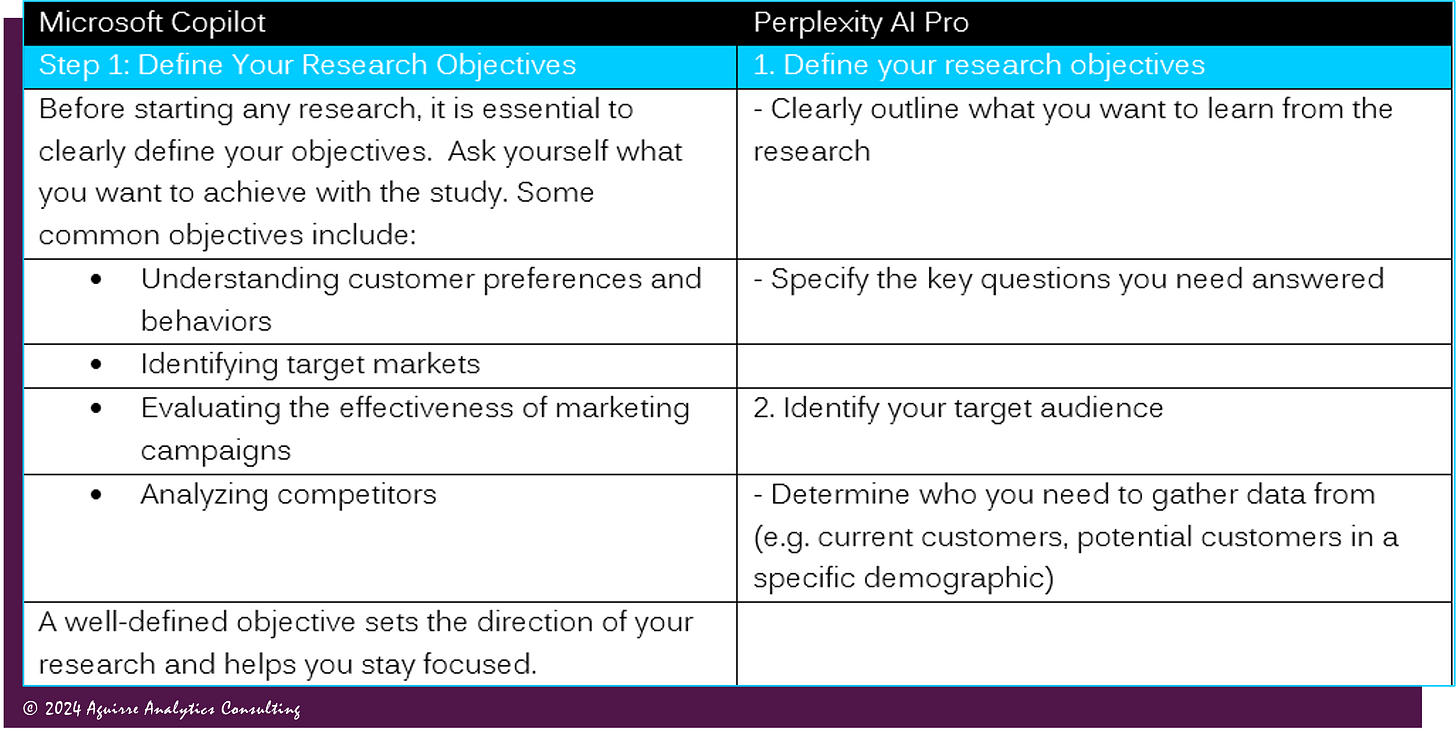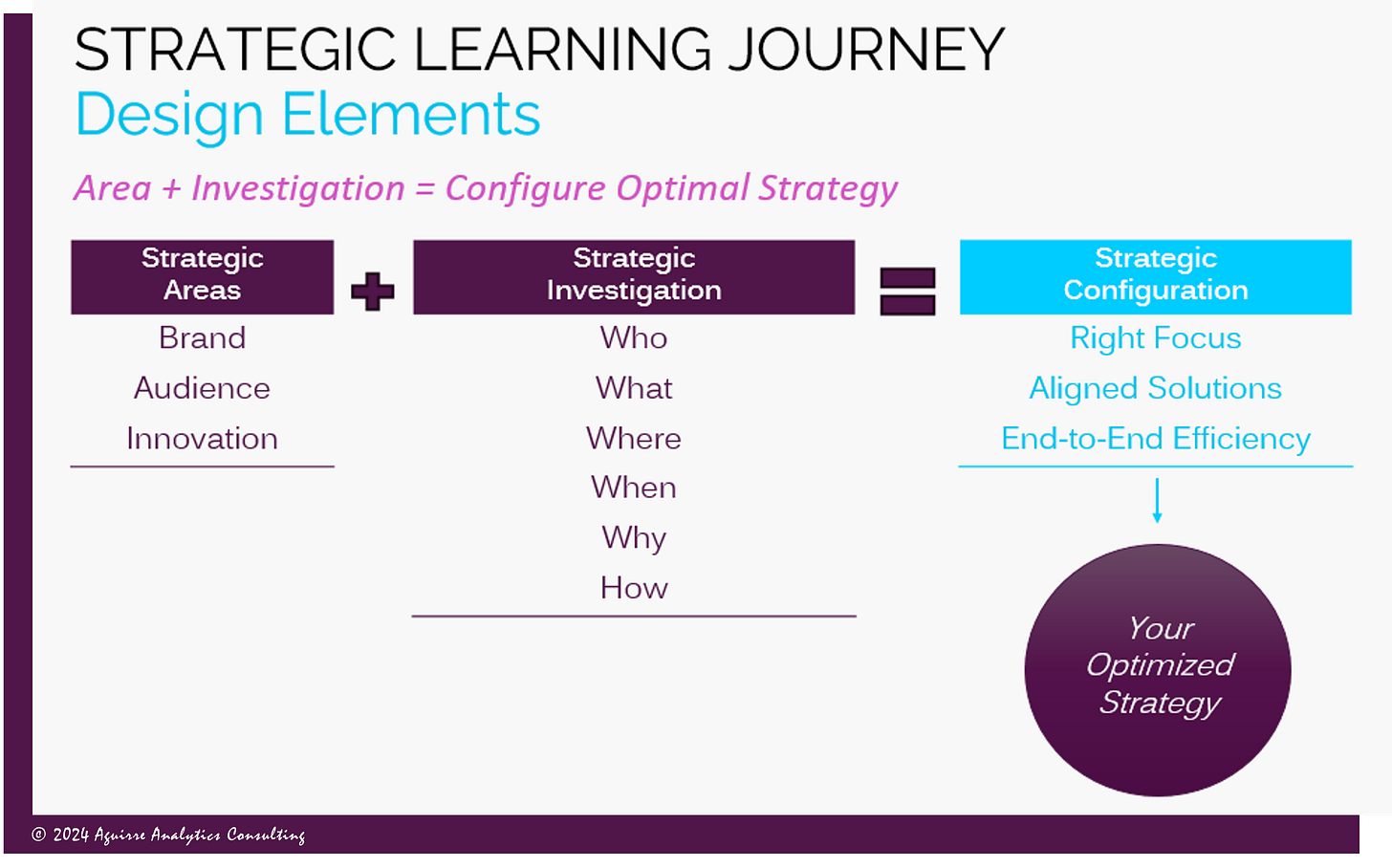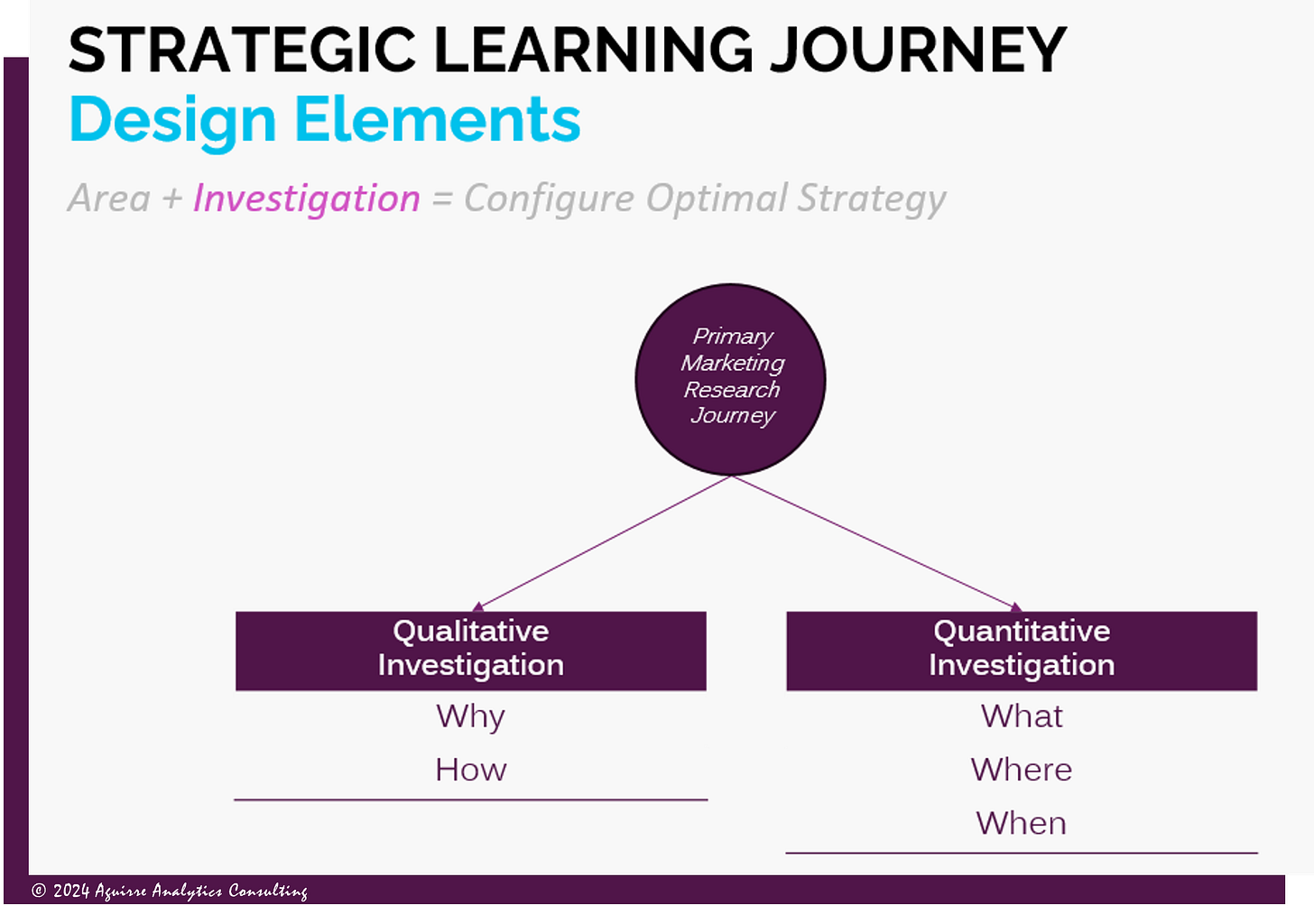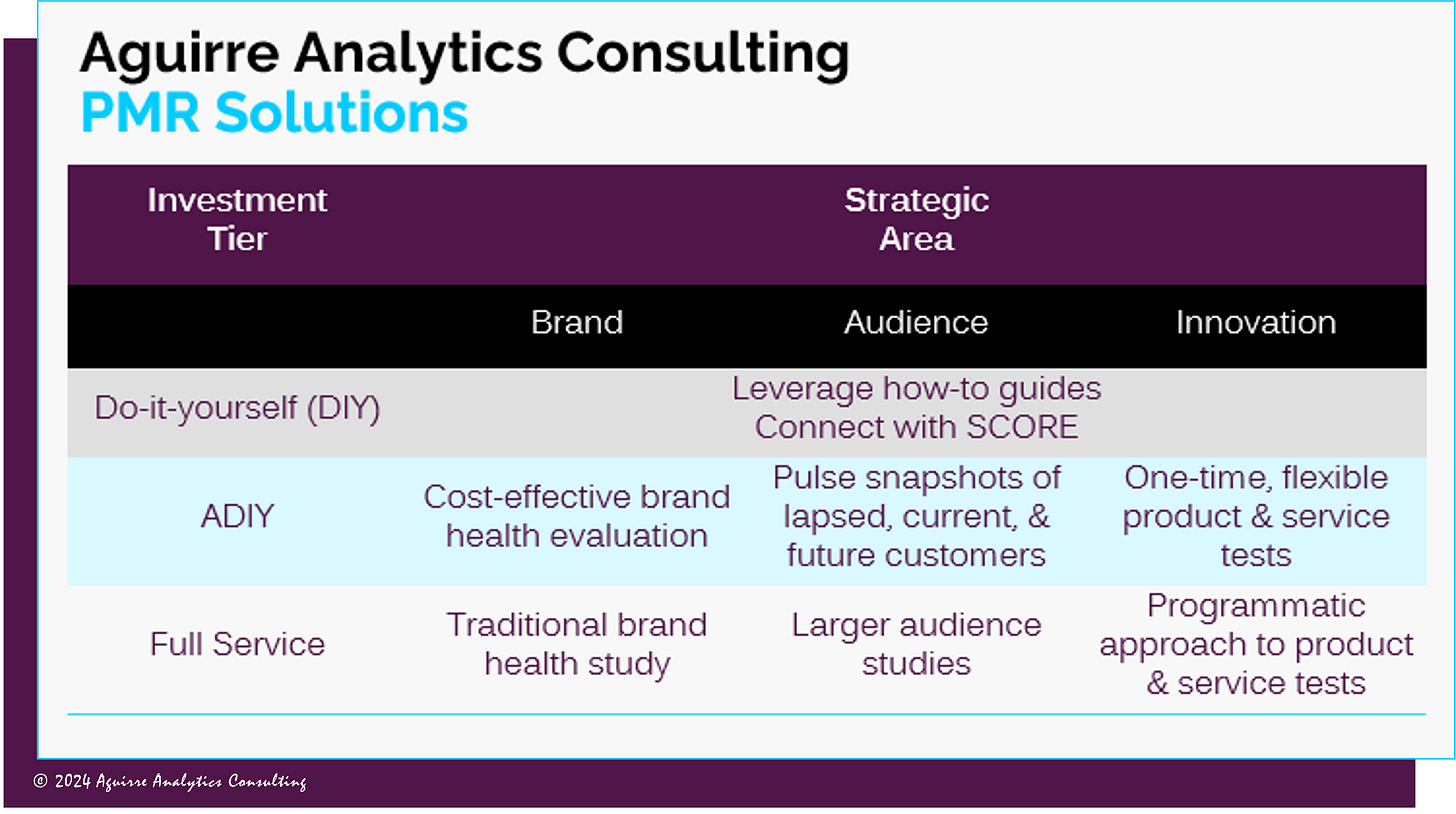The DIY primary marketing research journey with an AI research assistant.
And how to elevate with the #AguirreAnalytics Consulting Design Framework.
This is a living post. It was last updated 09.18.24.
Personas
As a reminder, this guide and post is meant for professionals who are new to primary marketing research (PMR) or professionals who are considering down shifting from a full-service investment.
If that’s you, welcome. We invite you to keep reading.
Through the course of this post, you should come to understand the paths of the PMR Solutions by Investment Tier across the Strategic Areas and how that framework aligns to your journey.
Our goal is to elevate your PMR journey by offering a strategic framework, addressing real pain points, and advising on optimal resource use.
AIRA
On a self-service journey, you’re likely heavily invested in artificial intelligence (AI) or heading in that direction. So, let’s do that strategically for PMR. Specifically, we’re going to demonstrate what your experience might be with your artificial intelligence research assistant (AIRA, rhythms with Sarah) and how to elevate the strategy.
Let’s get started.
Here’s how you might write your first prompt.
The unmodified AI output is below. Take the time to read the recommendation from each AI-powered productivity tool.
Step 1
Two points for AIRA nudging you to build your objectives, key questions, and method. A basic but always useful first step. And let’s make explicit how to “select methods that align with your objective and audience”.
Design Elements
Our Design Framework takes a building block approach using Design Elements. The intent? To navigate you down design paths mapped to your business objectives (Strategic Area & Strategic Investigation).
This means, our Design Framework assumes most of your business insight needs map to questions about your brand, audience, and innovations (that aligns to the AI generated bullet list in step 1). And those questions need to map to quantitative or qualitative approaches (the AI recommends more options, but our services are narrower).
In our experience, the breath of questions a business needs to address can grow quickly so the Design Framework is a useful map to stay oriented and anchored. And it’s simple and effective.
Even if you are new to PMR, your list of questions may grow very fast especially if you’re an early-stage firm or contending with serious business problems related to your brand, customers, or innovations.
Step 2
Next, AIRA recommends you begin building your study.
Sound advice. Nevertheless, before you proceed with developing tools, we recommend focusing on a research asset. This goes beyond merely detailing your business goals.
Consider research assets as the roadmap for the PMR strategy. A research brief, the most typical research asset, aligns business insight needs with the study design, method choice(s), audience considerations, and project cost(s). It also outlines required resources and assumptions across different scenarios (e.g., good, better, & best tiers). Other asset types include a statement of approach or a research roadmap. Remember, you can collaborate with us on these assets at no charge.
Now on to building tools but instead of solely relying on AIRA, first consider existing question libraries to save time and resources. Here’s a Google sheet with links to various templates organized by our Design Framework. While these templates may not exactly fit our PMR solution advice, they are useful for starting out or generating ideas for further prompt engineering.
At this step, we invite you to visit our prior DIY post to learn about: Screener Design Considerations, Main Survey Design Considerations, Collecting Demographic Data, & How to create a survey in QuestionPro.
End-to-end Efficiency
At this point, if your business has relatively straightforward insight needs you may be well on your way to building a PMR DIY solution. To be specific and to revisit the PMR solutions matrix, we assume the area of Innovation is where success is most likely to be had on a DIY path. On that journey, you will rely primarily on free guides which will probably be heavily dependent on your platform choice (our recommendations will point you to QuestionPro). And if you’re a small business owner, SCORE is a volunteer organization that offers free resources. Over time, more PMR content from Aguirre Analytics will surface on their website to inform the DIY path.
Our POV is Brand and Audience tend to have higher levels of complexity (pain points) which may shift you away from the DIY path. On the other hand, if you’re a savvy research-minded professional with a good grasp of methods (design), technology (ResTech), and operations (ResOps) you can probably move through solution paths more quickly and with little concern of barriers to progress (i.e., risks, inefficiencies, scope creep, etc.).
Step 3
Now on to the data collection strategy which is aligned to the study method, platform choice, and audience (i.e., sample source, sample size, margin of error, etc.) and fielding considerations.
A good deal of time will be spent 1) building the final tool, 2) coordinating the launch, and 2) managing the data collection needs. The micro-steps in this stage are heavily platform dependent so during this step its best to lean into platform how-to guides.
Feel free to use this resource to learn about sample size needs (Use this Google search input to track down other resources on QuestionPro: “sample size calculator site:questionpro.com”.) or ask AIRA.
Here’s our general recommendations on sample size:
Step 4
At last, you have your data! As you near the stage of extracting actual value from it, it's crucial to conduct one final quality check before proceeding with creating the final set of crosstabs (the most typical survey summary output). For now, we will set aside the marketing science, data science, and feature-based analytic considerations mentioned below and plan to revisit these in the future. Again, if you have a more urgent need, feel free to reach out to us.
Step 5
After cleaning your summary data, take a moment to draft an insights plan. If you're using PowerPoint, check out the video on Microsoft's new Narrative Builder. While the feature aims to align with an analytic plan for insight development, it's too soon to say it will speed up insight generation specifically for PMR data. Nonetheless, the strategy is aligned with what we commonly recommend - planning the build before venturing to build.
Final Thoughts & Future Additions
Hopefully this first pass on the comparison of your AI RA vs. our Design Framework was helpful and you learned something. As noted above, this is a living post, and additional content will be added or extended.
To this point, we have not yet discovered an AI tool that effectively analyzes quantitative survey data in the framework we would recommend. This gap persists and remains a challenge. Rather, most existing AI tools focus on qualitative data and in that space the low hanging fruit has been solved. We aim to evaluate how well these tools develop insights to highlight potential benefits.
Lastly, below are a few short clips from our full overview of the Design Framework to help keep this top of mind and easy to digest:
Follow us to join the conversation, we’d love to learn what more you want to learn.
© 2024 Aguirre Analytics Consulting. All rights reserved.


















